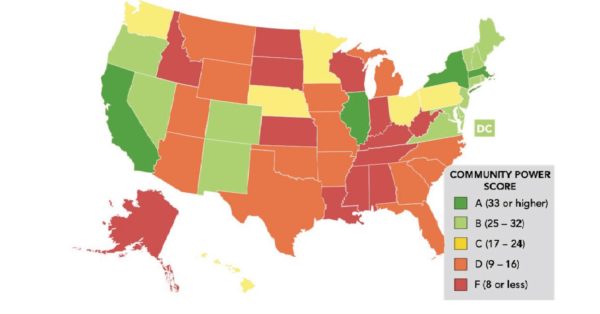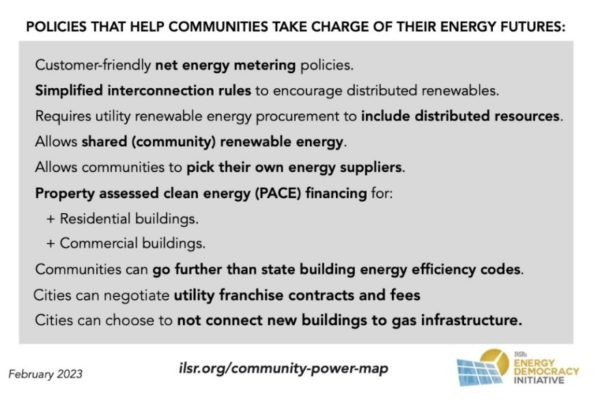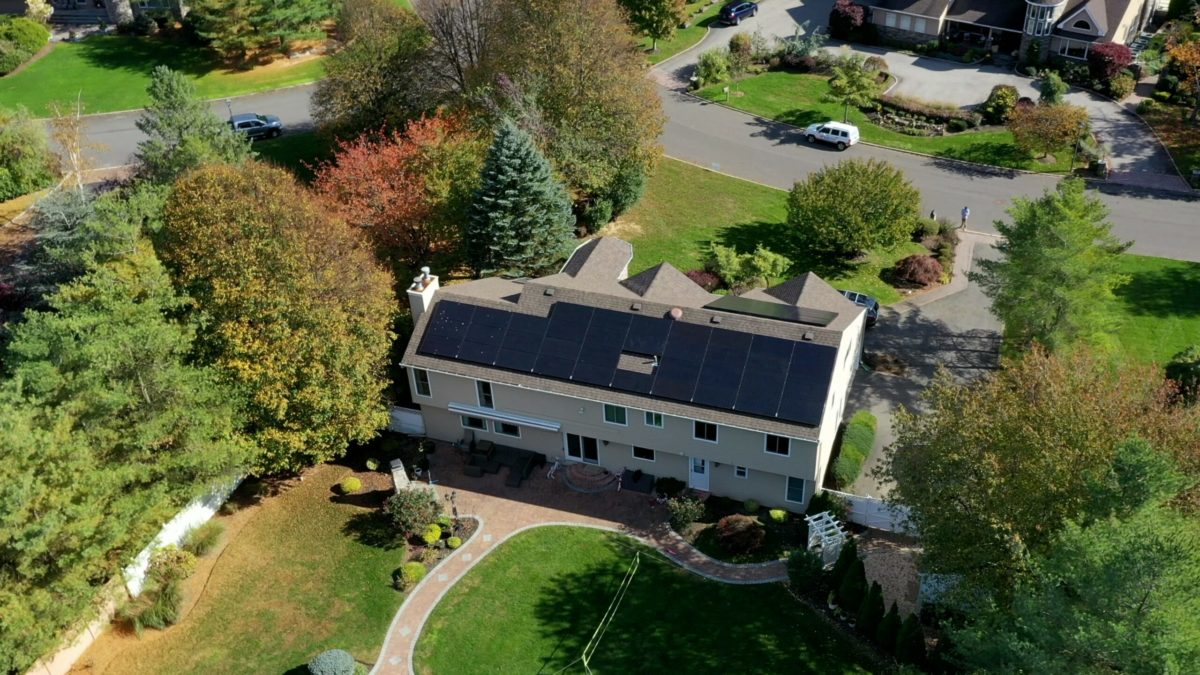Each year, the Institute for Local Self-Reliance (ILSR) tracks and scores states based on how their policies help or hinder local clean energy action. ILSR gives the states a letter grade of A, B, C, D or F based on whether its energy policies give individuals, cities and communities the choice to build clean energy wealth locally, rather than relying on utilities.
A number score is arrived at based on a compilation of data from the American Council for an Energy-Efficient Economy (ACORE), DSIRE, the National Renewable Energy Laboratory (NREL) , PACENation, SolarReviews, and Vote Solar, as well as the data the ILSR tracks on community solar, community choice aggregation and state legislative changes.
In the 2023 Community Power Scorecard, four states excelled, 14 states and the District of Columbia saw above average scores, six were average, 14 were mediocre, and 13 states received failing grades. Progress is being made, however, as seen by the numbers in the 2022 Scorecard in which four states excelled, nine states and the District of Columbia saw above average scores, nine were average, 15 were mediocre, and 13 states received failing grades.

Image: ILSR
Achieving a top score
The four states to receive an A grade are Massachusetts, California, Illinois and New York. To achieve a top score, ILSR’s community power scorecard evaluates state policies as they are written, not on how they have been implemented. Sound policy making that will advance energy democracy requires continued advocacy, vigilance, and effort, ILSR reports. An “A” grade does not mean that the work is done. Even in high-scoring states, like Massachusetts or California, the work continues.

New policies enacted last year in several states impacted their 2023 scores. These include California, Illinois, Maryland, and New Mexico, which each changed their interconnection rules for distributed energy resources. All four states added specific considerations for battery storage, which is something the Interstate Renewable Energy Council (IREC) advocates for with its BATRIES interconnection reform package. Out of those states, only Maryland had a less-than-perfect interconnection grade, so Maryland’s Community Power Score increased by one point.
The Washington and New Hampshire legislatures each demonstrated their desire to increase solar access with community solar policies that make specific accommodations for low-income subscribers (Wash. HB1814 and N.H. SB270). California did not receive any additional points for its new community solar policy, even though the policy improves upon the state’s existing Enhanced Community Renewables program. Several other states explored, but did not implement community solar in 2022, including Arizona, Ohio, and West Virginia.
Colorado’s General Assembly passed a law on building energy codes in 2022, which sets the 2021 International Energy Conservation (IEC) code as the minimum requirement, while still allowing communities to set more stringent codes.
Net metering policies lowered the score in several states. For example, Iowa and New York both added fees to self-generating customers. The Indiana Utility Regulatory Commission allowed the state’s utilities to switch to “instantaneous netting,” which dramatically reduces the value of customer-owned solar generation.
In December 2022 the California Public Utilities Commission (CPUC) unanimously voted to approve Net Energy Metering 3.0 (NEM 3.0), slashing payments for excess solar production sent to the grid by 75%. The Solar Energy Industries Association (SEIA) said the decision is “too abrupt” and will slow rooftop solar deployment in the state. “The failure to adopt a more gradual transition to net billing risks putting solar out of reach for millions of residents across the state,” said SEIA.
This content is protected by copyright and may not be reused. If you want to cooperate with us and would like to reuse some of our content, please contact: editors@pv-magazine.com.









“In December 2022 the California Public Utilities Commission (CPUC) unanimously voted to approve Net Energy Metering 3.0 (NEM 3.0), slashing payments for excess solar production sent to the grid by 75%. The Solar Energy Industries Association (SEIA) said the decision is “too abrupt” and will slow rooftop solar deployment in the state. “The failure to adopt a more gradual transition to net billing risks putting solar out of reach for millions of residents across the state,” said SEIA.”
Comment: When I installed my first solar in 2007, it cost $8.00 per watt and was still able to get a payback on the high PG&E rates “off-Grid”. With todays $3.00 per kilo watt hour solar panels and $ 550.00 per kilo watt hour for lithium storage that will last 12 years or $150.00 per kilo watt hour for lead acid batteries that last 6 years, it is still a value to install solar “off-Grid” in California under NEM 3.0. Sending power to the grid, under NEM 3.0, will be a losing proposition but keeping it all with battery storage will give 100% of the system value to the homeowner and reduce their carbon footprint as well as the monthly utility bill. Grid tied was all the rage under NEM2.0 since there was full value for the electricity produced. Now batteries will be the “IN thing” to save money and will provide truly green electricity all the time, day or night, unlike grid tied that uses fossil fuels to power the home at night.